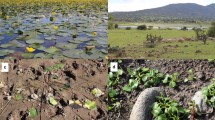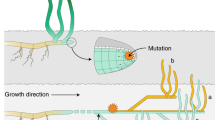Abstract
Aquatic plants are a biological group sharing several adaptations to aquatic conditions. The most striking evolutionary convergence in this group is the extensive reliance on clonal reproduction, which largely determines the patterns and process of evolution in aquatic plants. Utricularia australis f. tenuicaulis is a free-floating aquatic bladderwort that reproduces both sexually via seeds and clonally via turions and shoot fragments. Amplified fragment length polymorphism analysis was conducted on 267 ramets collected from 30 populations in Japan. The genotypic diversity within populations was extremely low, regardless of the geographical distribution range: the mean number of genotypes per population (G) was 1.4 and the mean genotypic diversity (D), including monoclonal populations, was 0.17. In contrast to the predominance of a few clones within populations, many of the populations investigated had different genotypes; a large portion of the genetic variation was explained by variation among populations. Character compatibility analysis clearly revealed that somatic mutations did not contribute to the origin of genotypic diversity in this aquatic bladderwort; instead, rare-to-sporadic sexual reproduction probably generated new genotypes. Thus, future studies should examine the role of sexual reproduction in this species from the viewpoint of long-term evolutionary benefits.



Similar content being viewed by others
References
Araki S, Kadono Y (2003) Restricted seed contribution and clonal dominance in a free-floating aquatic plant Utricularia australis R. Br. in southwestern Japan. Ecol Res 18:599–609
Barrett SCH, Eckert CG, Husband BC (1993) Evolutionary processes in aquatic plant populations. Aquat Bot 44:105–145
Casgrain P, Legendre P (1999) The R package for multivariate and spatial analysis, version 4.0. User’s manual. Department of Biological Sciences, University of Montreal, Montreal (http://www.bio.umontreal.ca/Casgrain/en/labo/R/v4/index.html)
Ceplitis A (2001) The importance of sexual and asexual reproduction in the recent evolution of Allium vineale. Evolution 55:1581–1591
Crow JF, Kimura M (1965) Evolution in sexual and asexual populations. Am Nat 99:439–450
Dice LR (1945) Measures of the amount of ecological association between species. Ecology 26:297–302
Dorken ME, Eckert CG (2001) Severely reduced sexual reproduction in northern populations of a clonal plant, Decodon verticillatus (Lythraceae). J Ecol 89:339–350
Eckert CG (2002) The loss of sex in clonal plants. Evol Ecol 15:501–520
Eckert CG, Lui K, Bronson K, Corradini P, Bruneau A (2003) Population genetic consequences of extreme variation in sexual and clonal reproduction in an aquatic plant. Mol Ecol 12:331–344
Ellstrand NC, Roose ML (1987) Patterns of genotypic diversity in clonal plant species. Am J Bot 74:123–131
Excoffier L, Smouse PE, Quattro JM (1992) Analysis of molecular variance inferred from metric distances among DNA haplotypes: application to human mitochondrial DNA restriction data. Genetics 131:479–491
Grace JB (1993) The adaptive significance of clonal reproduction in angiosperms: an aquatic perspective. Aquat Bot 44:159–180
van der Hulst RGM, Mes THM, den Nijs JCM, Bachmann K (2000) Amplified fragment length polymorphism (AFLP) markers reveal that population structure of triploid dandelions (Taraxacum officinale) exhibits both clonality and recombination. Mol Ecol 9:1–8
van der Hulst RGM, Mes THM, Falque M, Stam P, den Nijs JCM, Bachmann K (2003) Genetic structure of a population sample of apomictic dandelions. Heredity 90:326–335
Kadono Y (1994) Aquatic plants of Japan. Bun-ichi Sogo-Shuppan, Tokyo (in Japanese)
Kameyama Y, Toyama M, Ohara M (2005) Hybrid origins and F1 dominance in the free-floating, sterile bladderwort, Utricularia australis f. australis (Lentibulariaceae). Am J Bot 92:469–476
Komiya S, Shibata C (1980) Distribution of the Lentibulariaceae in Japan. Bull Nippon Dent Univ 9:163–212
Les DH, Philbrick CT (1993) Studies of hybridization and chromosome number variation in aquatic angiosperms: evolutionary implications. Aquat Bot 44:181–228
Lynch M, Lande R (1993) Evolution and extinction in response to environmental change. In: Kareiva PM, Kingsolver JG, Huey RB (eds) Biotic interactions and global change. Sinauer Associates, Sunderland, pp 234–250
Maynard Smith J (1978) The evolution of sex. Cambridge University Press, Cambridge
Mes THM (1998) Character compatibility of molecular markers to distinguish asexual and sexual reproduction. Mol Ecol 7:1719–1727
Mes THM, Kuperus P, Kirschner J, Štepánek J, Štorchová H, Oosterveld P, den Nijs JCM (2002) Detection of genetically divergent clone mates in apomictic dandelions. Mol Ecol 11:253–265
Peakall R, Smouse PE (2001) GenAlEx V5: Genetic Analysis in Excel—population genetic software for teaching and research. Australian National University, Canberra (http://www.anu.edu.au/BoZo/GenAlEx/)
Philbrick CT, Les DH (1996) Evolution of aquatic angiosperm reproductive systems. Bioscience 46:813–826
Pielou EC (1969) An introduction to mathematical ecology. Wiley-Interscience, New York
Stewart CN Jr, Via LE (1993) A rapid CTAB DNA isolation technique useful for RAPD fingerprinting and other PCR applications. BioTechniques 14:748–750
Taylor P (1989) The genus Utricularia: a taxonomic monograph. Royal Botanical Gardens, Kew
Vos P, Hogers R, Bleeker M, Reijans M, van de Lee T, Hornes M, Frijters A, Pot J, Peleman J, Kuiper M, Zabear M (1995) AFLP: a new technique for DNA fingerprinting. Nucleic Acids Res 23:4407–4414
Widén B, Cronberg N, Widén M (1994) Genotypic diversity, molecular markers and spatial distribution of genets in clonal plants, a literature survey. Folia Geobot Phytotaxon 29:245–263
Wilkinson M (2001) PICA 4.0: software and documentation. Department of Zoology, The National History Museum, London (http://www.nhm.ac.uk/research-curation/projects/software/mwphylogeny.html)
Acknowledgments
We acknowledge the helpful advice of Dr. Satoru Araki, Research Center for Coastal Lagoon Environments, Shimane University, and Prof. Yasuro Kadono, Faculty of Science, Kobe University. We are also grateful to Mr. Masahiro Toyama, Ebetsu City, Hokkaido; Mr. Shigeru Uematsu, Sapporo City, Hokkaido; Mrs. Kazuko Oita, Sapporo City, Hokkaido; Mr. Kazuyoshi Katsumata, Sapporo City, Hokkaido; Mr. Seikoh Iwamura, Saga City, Saga Prefecture; Mr. Noriyuki Sanemitsu, Kozan Town, Hiroshima Prefecture; Prof. Sadashi Komiya, Department of Biology, Nippon Dental University; and Prof. Michiko Shimoda, College of Environment and Disaster Research, Fuji Tokoha University, for helpful information. We also thank Dr. Yoshihisa Suyama, Graduate School of Agricultural Science, Tohoku University, for his technical advice about AFLP analysis. This study was supported by a Grant-in-Aid from the Ministry of Education, Culture, Sports, Science, and Technology for the 21st Century Center of Excellence Program (E-01) and from the Japan Society for the Promotion of Science (JSPS) for Scientific Research (15370006 and 16370007) and Research Fellowships for Young Scientists.
Author information
Authors and Affiliations
Corresponding author
Rights and permissions
About this article
Cite this article
Kameyama, Y., Ohara, M. Predominance of clonal reproduction, but recombinant origins of new genotypes in the free-floating aquatic bladderwort Utricularia australis f. tenuicaulis (Lentibulariaceae). J Plant Res 119, 357–362 (2006). https://doi.org/10.1007/s10265-006-0282-2
Received:
Accepted:
Published:
Issue Date:
DOI: https://doi.org/10.1007/s10265-006-0282-2




